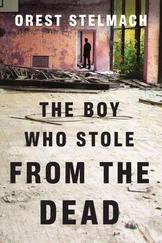The air is becoming grayer and grayer. Gunnar knew it was going to be foggy, he was counting on it, and that’s why Nils was allowed to come home on this particular day. What else has he worked out so carefully? Nils wonders.
North of Köpingsvik, Gunnar switches on the fog lights and increases his speed. Nils can see the yellow signs rushing by. The familiar names of Öland villages. But it’s the landscape that he can’t tear his eyes away from: the fields, the grass growing wild, the stone walls that start by the road and disappear off into the fog.
And the alvar, his very own alvar. The alvar extends in all directions; with its heavy, muted colors and its endless sky, it’s just as big and beautiful as he remembered.
Nils is home again.
No one in the car speaks, and after a quarter of an hour Nils sees the sign he’s been waiting for. STENVIK. Beneath it is a big arrow with the word CAMPSITE on it.
The road down to the village is tarmac now, and Stenvik has acquired a campsite. When did that happen?
The car drives past the turning for Stenvik before slowing down.
“We’ll take the northern entry road,” says Gunnar. “There’s less traffic there, and we won’t have to drive through the village.”
A few minutes later he turns the car onto the northern route into the village, beside a milk stand, empty and abandoned by the roadside. Last time Nils saw the milk stand, it was full of milk churns from the farms along the road; now it’s spotted with white lichen, and looks as if it’s about to fall to pieces.
The whole of Öland has changed in twenty-five years, but this northern road down into Stenvik is almost exactly as he remembers it: narrow and twisting, and still graveled. It’s completely deserted, with grass-filled ditches on both sides and the alvar beyond them.
Gunnar allows the Volvo to move slowly forward, and after a few hundred yards he stops completely. He turns to look at Nils, and beside him Martin turns around, too.
Gunnar is looking steadily at him, Nils notices. Martin’s gaze wavers.
“Okay,” says Gunnar seriously, “we’ve brought you to Stenvik. And now you’re going to dig up your treasure by the cairn. Right?”
“I want to see my mother first,” says Nils, gazing steadily at Gunnar.
“Vera isn’t going anywhere, Nils,” he says. “She can wait awhile longer. It’s best that way, because it’s better if it’s really dark before we go down to the village. Don’t you think so?”
“We’ll split the stones between us,” says Nils quickly.
“Of course. But we’ve got to get them up first.”
Nils looks at him for a few seconds longer, and then he looks out of the side window. The fog is dense now, and soon it will be twilight.
He nods. He’ll give Gunnar and Martin half of the gemstones, then they’ll be quits.
“We’ll need something to dig with,” he says quietly.
“Sure. There are shovels and a pick in the trunk,” says Gunnar. “We’ve thought of everything. Don’t worry.”
But Nils doesn’t relax. He’s on his own against two strange men now, just as the man from Småland was on his own on the Caribbean beach in the darkness. The difference is that the man from Småland trusted his new friends — Nils doesn’t.
Gunnar doesn’t park by the road; he brakes by a narrow opening in the stone wall and turns the wheel. The car leaves the village road.
Slowly they move out onto the flat, grassy plain of the alvar.
Nils turns his head, but all he can see through the back window is fog. The road leading down to his home village has completely disappeared.
Gerlof sat in silence in the passenger seat beside Gunnar Ljunger, his back rigid as they headed out into the wilderness south of Marnäs. The conversation he had tried to start had foundered, because Ljunger didn’t answer him. All Gerlof could do was to go along with him, trying to unbutton his overcoat and struggle out of it, because the heat inside the car was positively tropical. Perhaps there was some way to regulate the air vents on the passenger side himself, but he didn’t know how. Everything seemed to be controlled electronically, and if Gunnar knew he was increasingly uncomfortable, he made no attempt to help him.
They were near the east coast of the island now. The car was driving slowly along a two-foot-high embankment, several yards wide, running through the flat landscape. Gerlof recognized where he was. This was where the railway had crossed the alvar, before the national rail company closed it down.
He looked at his watch. It was almost five o’clock.
“I think I’ll have to get back now, Gunnar,” he said quietly. “They’ll soon be starting to wonder where I am at the home in Marnäs.”
“Maybe,” Ljunger said, nodding, “but they’re hardly likely to start looking for you out here, are they?”
The threat was so blatant that Gerlof turned away from him and started tugging at the door handle.
The Jaguar wasn’t moving at a great speed and he would have been able to throw himself out, he might even have managed to avoid breaking any bones and made his way back to the main road before dark — but it was impossible to open the passenger door. Ljunger had locked it using some kind of remote control device.
“Gunnar, I want to get out,” he said, trying to sound decisive, like the sea captain he had once been.
“Soon,” said Ljunger, driving on.
They crossed an old rusty cattle grid between two stone walls, and beyond it the Baltic finally appeared. The sea looked gray and cold.
“Why are you doing this, Gunnar?” asked Gerlof.
“Actually, it was quite unplanned,” said Ljunger. “I was following the bus from Borgholm, and I saw you get off at the southern turning for Stenvik. All I had to do was head straight to the northern turning, drive through the village, then pick you up.” Ljunger slowed down even more, and turned to face him. “What were you doing at Martin Malm’s today, Gerlof?”
Gerlof felt as if he’d been found out. He took his time before answering.
“At Martin’s?” he said. “What do you mean?”
“You and John Hagman,” said Ljunger. “You went in and John waited outside.”
“Yes. Martin and I had a bit of a chat... We’re both old sailors, after all,” said Gerlof, and added: “How do you know about that?”
“Ann-Britt Malm called me on my cell phone while you were sitting there talking over old times with Martin,” said Ljunger. “She was worried about all these visits Martin keeps getting from old sea captains... first Ernst Adolfsson, and now you. Twice in the last few weeks, apparently. It’s been pretty busy at Martin’s house.”
“So you and Ann-Britt are good friends,” said Gerlof wearily.
Ljunger nodded. “Martin and I are former business associates, but you don’t get much of a conversation with him these days,” he said. “Ann-Britt looks after his affairs, and she usually asks me for advice.”
Gerlof leaned back in his seat. Might as well stop pretending the sun was shining now. He couldn’t see anything out the window but darkness and blowing rain.
“Associates,” he said. “You worked together for quite some time, didn’t you? Ever since the fifties?”
He reached into his briefcase and took out the book about Malm Freight again.
“I showed Martin this picture,” he said, “and I’ve looked at it many times... but it took a long time before I saw what was really there.”
“Oh yes?” said Gunnar, swerving around a clump of low-growing trees. They must be near the sea, Gerlof thought. “But now you have? Seen what’s really there?”
Gerlof nodded. “There are two powerful men on the quayside in Ramneby: August Kant, the factory owner, and Martin Malm, the captain of a cargo ship, standing in a group of young sawmill workers. And August’s hand appears to be resting on Martin’s shoulder in a friendly gesture. But it isn’t August Kant’s hand. It belongs to the man standing behind Martin Malm on the quayside. I only noticed it a little while ago, on the bus.”
Читать дальше












